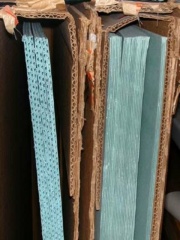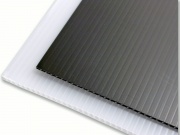Corrugated board
Jump to navigation
Jump to search
Description
A board that is folded or shaped with parallel alternative ridges and grooves. Corrugated or pleated Paper was patented in 1856 and in 1871 a patent was issued for corrugated Cardboard. By 1874, a machine was patented to make cellulosic corrugated board with liner sheets on each side. The alternating ridges increase the strength, and thickness of a material without increasing its weight. It is used for packaging and cushioning. Types of paper-based corrugated boards, such as Blueboard or Archival corrugated board, are often used in museums. More recently corrugated plastic sheets have also found multiple uses in museums.
Synonyms and Related Terms
- Cellulosic: blueboard; corrugated paper; pleated paper; corrugated brown; cardboard
- Plastic: fluted plastic sheet; polyflute; Coroplast, Cor-X, Correx, Hexlite, Hi-Core,Tycore, Corrulite, Corulite, and Diversi-Plast.
Resources and Citations
- Jean Tétreault, 'Products Used in Preventive Conservation – Technical Bulletin 32' CCI website
- Boise Cascade Paper Group, The Paper Handbook, Boise Cascade, Portland OR, 1989
- The Dictionary of Paper, American Paper Institute, New York, Fourth Edition, 1980
- E.J.LaBarre, Dictionary and Encyclopedia of Paper and Paper-making, Swets & Zeitlinger, Amsterdam, 1969 Comment: 1890 patented by G.M.Smith
- Wikipedia: http://en.wikipedia.org/wiki/Corrugated_board - gives the following patent dates: corrugated paper=1856 (England); corrugated cardboard=1871 (Albert Jones, U.S.); corrugated cardboard box=1890 (Robert Gair, U.S.)
- Book and Paper Group, Paper Conservation Catalog, AIC, 1984, 1989
- Art and Architecture Thesaurus Online, http://www.getty.edu/research/tools/vocabulary/aat/, J. Paul Getty Trust, Los Angeles, 2000

